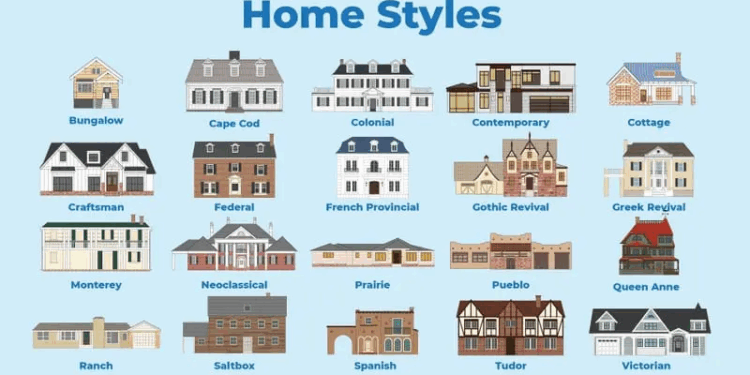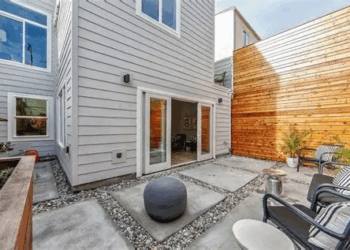
Dive into the world of home exteriors as we uncover the different styles that define the look of houses. From modern to traditional, each type offers a unique charm and character that sets it apart. Let’s take a closer look at how architectural styles and materials play a crucial role in shaping the exterior of a home.
As we delve deeper into the realm of home exteriors, we’ll discover the intricate details that make each type distinct and appealing.
Types of Home Exteriors
When it comes to home exteriors, there are various styles that can greatly influence the overall look of a house. From modern to traditional, each type has unique features that define its architectural design and materials used.
Modern Home Exteriors
Modern home exteriors are characterized by clean lines, minimalist design, and the use of materials such as glass, steel, and concrete. Large windows, flat roofs, and asymmetrical shapes are common features of modern homes. These exteriors often prioritize functionality and simplicity over ornate details.
Traditional Home Exteriors
Traditional home exteriors typically feature symmetrical designs, pitched roofs, and decorative elements like shutters and columns. Materials such as brick, wood, and stone are commonly used to create a classic and timeless look. These exteriors often evoke a sense of warmth and familiarity.
Contemporary Home Exteriors
Contemporary home exteriors blend elements of both modern and traditional styles. They may feature a mix of materials like wood, metal, and glass, as well as unique geometric shapes and angles. Contemporary exteriors often prioritize sustainability and energy efficiency in their design.
Colonial Home Exteriors
Colonial home exteriors are inspired by the architecture of early American settlers. They typically have symmetrical facades, columns, and gabled roofs. Clapboard siding and brick are common materials used for colonial exteriors, giving them a timeless and elegant appearance.
Comparison of Popular Materials
- Brick: Durable and classic, often used in traditional and colonial exteriors.
- Wood: Versatile and natural, suitable for a variety of styles including traditional and contemporary.
- Stone: Adds a sense of luxury and sophistication, commonly found in modern and traditional exteriors.
- Stucco: Provides a smooth and textured finish, popular in modern and contemporary designs.
- Steel: Modern and industrial, used in sleek and minimalist exteriors.
Popular Exterior Materials
When it comes to choosing materials for home exteriors, there are several popular options that homeowners can consider. Each material comes with its own set of advantages and considerations in terms of durability, maintenance, cost-effectiveness, and environmental impact.
Brick
Brick is a timeless choice for home exteriors, known for its durability and classic aesthetic appeal. It requires minimal maintenance and can withstand harsh weather conditions. However, the initial cost of brick installation can be higher compared to other materials.
Wood
Wood is a versatile material that adds warmth and character to a home’s exterior. While wood siding may require more maintenance in terms of regular painting or staining to prevent rot and decay, it can be cost-effective in the long run if properly maintained.
Vinyl
Vinyl siding is a popular choice for homeowners due to its affordability and low maintenance requirements. It is available in a variety of colors and styles, making it a versatile option for different home designs. However, vinyl may not be as durable as other materials and can fade or crack over time.
Stucco
Stucco is a durable material that offers excellent insulation properties for homes. It is low maintenance and can last for many years with proper care. While the initial installation cost of stucco may be higher, it can provide long-term cost savings through energy efficiency.
Stone
Natural stone siding adds a luxurious and elegant look to a home’s exterior. It is a durable material that can withstand the elements and requires minimal maintenance. However, the cost of stone siding can be higher compared to other materials, making it a premium option for homeowners.
Metal
Metal siding, such as aluminum or steel, is a durable and low-maintenance option for home exteriors. It is resistant to fire, pests, and rot, making it a long-lasting choice for homeowners. While metal siding may have a higher upfront cost, it can provide cost savings over time due to its longevity.
Color Schemes and Finishes
When it comes to home exteriors, the color scheme and finish play a crucial role in enhancing curb appeal and overall aesthetic appeal. Choosing the right combination can complement the architectural style of the house and create a welcoming first impression.
Popular Color Schemes for Home Exteriors
- Neutral Tones: Shades of beige, gray, and white are timeless choices that provide a clean and classic look.
- Earthy Hues: Colors inspired by nature such as greens, browns, and blues can create a harmonious blend with the surroundings.
- Bold Accents: Adding a pop of color like red, navy, or black to doors, shutters, or trims can make a statement and add personality.
Types of Finishes and Their Impact
- Matte Finish: Offers a subtle and sophisticated look, hiding imperfections and providing a smooth appearance.
- Glossy Finish: Reflects light and adds a polished sheen, creating a vibrant and modern appeal.
- Textured Finish: Provides depth and character, adding visual interest and a rustic charm to the exterior.
Tips for Choosing the Right Color Scheme and Finish
- Consider the architectural style of your home and choose colors that complement its design elements.
- Take into account the surroundings, such as landscaping, neighboring houses, and natural light, to ensure harmony.
- Test samples on different areas of the house to see how they look in various lighting conditions before making a final decision.
Trends in Color Choices for Home Exteriors
- Currently, earthy tones and neutral palettes remain popular for a timeless and elegant look.
- Modern homes often opt for monochromatic schemes with contrasting accents for a sleek and contemporary appearance.
- Historic homes may stick to traditional color schemes to preserve their architectural authenticity and charm.
Landscaping and Exterior Design
Landscaping plays a crucial role in enhancing the overall appearance of different types of home exteriors. It not only adds curb appeal but also creates a harmonious connection between the house and its surroundings.
Integrating Landscaping Elements
When designing the landscaping for your home exterior, consider incorporating elements such as gardens, pathways, and lighting to complement the overall design. A well-planned garden can soften the edges of a modern home exterior, while a winding pathway can add a touch of charm to a traditional facade.
Strategically placed lighting can highlight architectural features and create a welcoming ambiance.
Harmony Between Home Exterior and Landscaping
Achieving harmony between the home exterior and landscaping is essential for a cohesive look. The colors, textures, and materials used in the landscaping should complement the exterior of the house. For example, if you have a rustic farmhouse exterior, opt for a garden with wildflowers and a gravel pathway to maintain the country charm.
Selecting Plants and Hardscaping Features
When selecting plants and hardscaping features, consider the style of your home’s exterior. Choose plants that thrive in your climate and complement the architectural style of your house. For a modern home, sleek planters and minimalistic landscaping can enhance the contemporary look.
In contrast, a cottage-style home may benefit from a mix of colorful flowers and a quaint picket fence.
Summary
In conclusion, the diverse array of home exterior types, materials, colors, and landscaping options provide homeowners with endless possibilities to create a personalized and aesthetically pleasing living space. By understanding the nuances of each element, individuals can transform their homes into unique reflections of their style and personality.
FAQ Summary
What are some unique features that define each type of home exterior?
Each type of home exterior, whether modern, traditional, contemporary, or colonial, has distinctive features such as architectural details, roof styles, and window shapes that set them apart from one another.
What is the cost-effectiveness of different exterior materials?
The cost-effectiveness of exterior materials varies depending on factors like durability, maintenance requirements, and initial installation costs. For example, while wood may require more maintenance, it can provide a classic and timeless look.
How do color schemes impact the curb appeal of home exteriors?
Color schemes play a crucial role in enhancing the curb appeal of home exteriors. Choosing the right colors can make a home stand out and create a welcoming facade for visitors.
Why is harmony between home exterior and landscaping important?
Harmony between the home exterior and landscaping is crucial for creating a cohesive look that enhances the overall aesthetic appeal of the property. It ensures that the exterior design and landscaping elements complement each other harmoniously.














